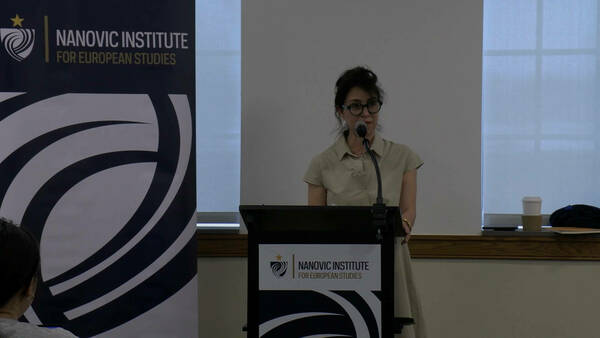
Hannah Feldman is an associate professor of art history and core faculty in Middle Eastern and North African studies as well as comparative literary studies. Her research, teaching, and advising center on late modern and contemporary art and visual culture. Her first book, From a Nation Torn: Decolonizing Art and Representation in France (Duke University Press, 2014), has been reviewed in over ten national and international publications, including Art Journal, Art Bulletin, and The American Historical Review. The book revises accounts of mid-century French aesthetics to argue for the centrality of decolonization to the contemporaneous theorization of urban space, photography, the public, spectacle, and the very project of writing history.
Salvatore Riolo, a Ph.D. candidate in Italian Studies at the University of Notre Dame, has written a summary of Moudileno’s lecture, which may also be re-watched on the Nanovic Institute’s YouTube page.
On March 4th, 2024, Professor Hannah Feldman Ph.D., delivered an intellectually engaging lecture at the University of Notre Dame titled "Decolonizing Death (A Letter from a Pillar of Salt)", which explored the late-nineteenth-century understandings of what she calls “Photography in Arabic” through the work of Hrair Sarkissian and Ahlam Shibli, arguing that, instead of merely reflecting a history marked by death and displacement, the photographs illuminate an alternative social reality.
"Decolonizing Death (A Letter from a Pillar of Salt)": Decolonizing Scholarship with Hannah Feldman
Feldman begins by discussing the significance of integrating practice with scholarship in her work, which fits well with the goal of this lecture series. Her presentation revolves around how decolonization informs her ongoing work, creating parallels between what is considered modern here and there, without questioning what modern means. The study of Photography in Arabic protects artists from the so-called periphery to standardization, shedding light on our understanding of the semiotics of images. The central theoretical focus is therefore on the role of signification in photography. Things mean different things in different places, the basic principle of signification. It does not directly address Europe, but rather the consequences of Europe on the colonial periphery. In conducting this analysis, Feldman chose the form of the letter because of its social significance. The letter invites the listener into a participatory role scaffolding the idea of a concrete action and interaction between scholarship and social reality. Moreover, a letter arrives later and from another place, where matters have been permitted to gather, and events have been allowed to unfold during its inevitable delay and progression. The signature “from a pillar of salt” captures the sense of feeling ensnared, gazing back in either shock or empathy, unable to avert one's eyes, yearning for a shift in perspective. The artworks and individuals she addresses could similarly be interpreted as pillars of salt, grappling with the past while holding onto hope for a transformative future.
Photography in Arabic
In analyzing the works of this photographer, the examination of Western aesthetics and reality is approached by considering conceptual repression, which occurs when specific artistic standards dominate, eclipsing the diverse range of lived experiences. It is therefore pivotal to the discourse to reframe our artistic cannon and open our analysis to the epistemes of what is perceived as peripheral but is crucially embedded in the human experience and use of artworks. In Shibli's work, such as “Death,” the martyrs of the Second Intifada are remembered, blurring the lines between life and death. The photo captures not just the subject but also the essence of witnessing, reflecting an ambivalent meaning tied to the Arabic concept of shaheed (lit. martyr). Materiality plays a crucial role, as photography, while not keeping the subject alive, is intricately linked to death.
Phantasms and absence
Shibli's “Photography in Arabic” delves into phantasms and mirages, transcending mere temporality and witnessing. This approach stems from a worldview shaped by language, exemplified by the term al-fotographia, which literally means “the writing of light” in Arabic. Unlike Western views of photography as either art or science, Arabic photography, termed al-taswir, emphasizes the realm of the imaginary, or the "imaginal," as Henri Corbin coined it. Taswir, derived from the verb sawarra, implies active formation rather than representation, highlighting the dynamic nature of the image-making process. This terminology highlights the imaginal space where phantoms merge with reality.
Sarkissian's work further delves into this realm, creating a consciousness of an alternate reality rooted in loss and absence. While Western historians focus on facts, Sarkissian's imaginative portrayal provokes reflection on what could have been. The “Execution Square” series, printed on aluminum to intensify the glare, presents everyday settings with titles hinting at profound narratives. By choosing to portray vacant spaces, Sarkissian prompts contemplation of absence, challenging conventional notions of normality and its potential transformation. His method sparks critical dialogue, standing in stark contrast to sensationalized imagery such as the tragic death of Alan Kurdi. While Kurdi's image may evoke immediate social reactions, Sarkissian's portrayal of absence invites a more serene interpretation of societal issues.
An alternative social reality
"Truth is white, write over it
with a crow’s ink.
Truth is black, write over it
with a mirage’s light."Mahmoud Darwish, "To a Young Poet" (excerpt)
The interpretation of images by the public is diverse, often sparking debates regarding the hierarchical structures within theoretical criticism. Decolonization, in this context, necessitates a reevaluation of entrenched temporal categories and an expansion of perceptual boundaries beyond preconceived notions of justice and correctness. This entails not only challenging dominant narratives but also embracing alternative perspectives and marginalized voices to foster a more inclusive and equitable discourse. By dismantling established frameworks and embracing a multiplicity of viewpoints, decolonization paves the way for a richer understanding of art, culture, and society.
About the author

Salvatore Riolo, a Ph.D. candidate in Italian studies at the University of Notre Dame, earned a B.A. in languages, civilization, and the science of language at the University of Venice and an M.A. in linguistics at the University of Bologna. He was selected as a Nanovic Institute Graduate Fellow for the 2023-24 academic year and serves as co-editor for Europe in the World. His research background includes foreign languages and translation, specifically German, English, and Russian, textual linguistics in literary studies, and semiology. He also has experience as a teacher of Italian as a second and foreign language.